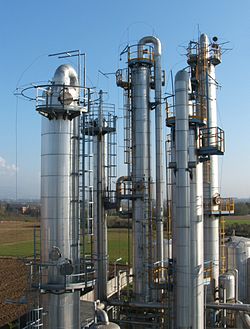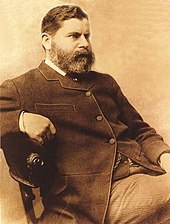Chemical engineering

Chemical engineeringis anengineeringfield which deals with the study of operation and design ofchemical plantsas well as methods of improving production. Chemical engineers develop economical commercial processes to convert raw materials into useful products. Chemical engineering uses principles ofchemistry,physics,mathematics,biology,andeconomicsto efficiently use, produce, design, transport and transform energy and materials. The work of chemical engineers can range from the utilization ofnanotechnologyandnanomaterialsin the laboratory to large-scale industrial processes that convert chemicals, raw materials, living cells, microorganisms, and energy into useful forms and products. Chemical engineers are involved in many aspects of plant design and operation, including safety and hazard assessments,process designand analysis,modeling,control engineering,chemical reaction engineering,nuclear engineering,biological engineering,construction specification, and operating instructions.
Chemical engineers typically hold a degree in Chemical Engineering orProcess Engineering.Practicing engineers may have professional certification and be accredited members of a professional body. Such bodies include theInstitution of Chemical Engineers(IChemE) or theAmerican Institute of Chemical Engineers(AIChE). A degree in chemical engineering is directly linked with all of the other engineering disciplines, to various extents.
Etymology
[edit]
A 1996 article cites James F. Donnelly for mentioning an 1839 reference to chemical engineering in relation to the production ofsulfuric acid.[1]In the same paper, however,George E. Davis,an English consultant, was credited with having coined the term.[2]Davis also tried to found a Society of Chemical Engineering, but instead, it was named theSociety of Chemical Industry(1881), with Davis as its first secretary.[3][4]TheHistory of Science in United States: An Encyclopediaputs the use of the term around 1890.[5]"Chemical engineering", describing the use of mechanical equipment in the chemical industry, became common vocabulary in England after 1850.[6]By 1910, the profession, "chemical engineer," was already in common use in Britain and the United States.[7]
History
[edit]New concepts and innovations
[edit]
In the 1940s, it became clear that unit operations alone were insufficient in developingchemical reactors.While the predominance of unit operations in chemical engineering courses in Britain and the United States continued until the 1960s,transport phenomenastarted to receive greater focus.[8]Along with other novel concepts, such asprocess systems engineering(PSE), a "second paradigm" was defined.[9][10]Transport phenomena gave ananalyticalapproach to chemical engineering[11]while PSE focused on its synthetic elements, such as those of acontrol systemandprocess design.[12]Developments in chemical engineering before and after World War II were mainly incited by thepetrochemical industry;[13]however, advances in other fields were made as well. Advancements inbiochemical engineeringin the 1940s, for example, found application in thepharmaceutical industry,and allowed for themass productionof variousantibiotics,includingpenicillinandstreptomycin.[14]Meanwhile, progress inpolymer sciencein the 1950s paved way for the "age of plastics".[15]
Safety and hazard developments
[edit]Concerns regarding large-scale chemical manufacturing facilities' safety and environmental impact were also raised during this period.Silent Spring,published in 1962, alerted its readers to the harmful effects ofDDT,a potentinsecticide.[16]The 1974Flixborough disasterin the United Kingdom resulted in 28 deaths, as well as damage to achemical plantand three nearby villages.[17]1984Bhopal disasterin India resulted in almost 4,000 deaths.[citation needed]These incidents, along withother incidents,affected the reputation of the trade asindustrial safetyandenvironmental protectionwere given more focus.[18]In response, the IChemE required safety to be part of every degree course that it accredited after 1982. By the 1970s, legislation and monitoring agencies were instituted in various countries, such as France, Germany, and the United States.[19]In time, the systematic application of safety principles to chemical and otherprocess plantsbegan to be considered a specific discipline, known asprocess safety.[20]
Recent progress
[edit]Advancements incomputer sciencefound applications for designing and managing plants, simplifying calculations and drawings that previously had to be done manually. The completion of theHuman Genome Projectis also seen as a major development, not only advancing chemical engineering butgenetic engineeringandgenomicsas well.[21]Chemical engineering principles were used to produceDNA sequencesin large quantities.[22]
Concepts
[edit]| Part ofa serieson |
| Chemical engineering |
|---|
| Fundamentals |
| Unit processes |
| Aspects |
| Glossaries |
|
|
|
Chemical engineering involves the application of several principles. Key concepts are presented below.
Plant design and construction
[edit]Chemical engineering design concerns the creation of plans, specifications, and economic analyses forpilot plants,new plants, or plant modifications. Design engineers often work in a consulting role, designing plants to meet clients' needs. Design is limited by several factors, including funding, government regulations, and safety standards. These constraints dictate a plant's choice of process, materials, and equipment.[23]
Plant construction is coordinated byproject engineersand project managers,[24]depending on the size of the investment. A chemical engineer may do the job of project engineer full-time or part of the time, which requires additional training and job skills or act as a consultant to the project group. In the USA the education of chemical engineering graduates from the Baccalaureate programs accredited byABETdo not usually stress project engineering education, which can be obtained by specialized training, as electives, or fromgraduate programs.Project engineering jobs are some of the largest employers for chemical engineers.[25]
Process design and analysis
[edit]A unit operation is a physical step in an individual chemical engineering process. Unit operations (such ascrystallization,filtration,dryingandevaporation) are used to prepare reactants, purifying and separating its products, recycling unspent reactants, and controlling energy transfer in reactors.[26]On the other hand, a unit process is the chemical equivalent of a unit operation. Along with unit operations, unit processes constitute a process operation. Unit processes (such asnitration,hydrogenation, andoxidationinvolve the conversion of materials bybiochemical,thermochemicaland other means. Chemical engineers responsible for these are calledprocess engineers.[27]
Process design requires the definition of equipment types and sizes as well as how they are connected and the materials of construction. Details are often printed on aProcess Flow Diagramwhich is used to control the capacity and reliability of a new or existing chemical factory.
Education for chemical engineersin the first college degree 3 or 4 years of study stresses the principles and practices of process design. The same skills are used in existing chemical plants to evaluate theefficiencyand make recommendations for improvements.
Transport phenomena
[edit]Modeling and analysis of transport phenomena is essential for many industrial applications. Transport phenomena involvefluid dynamics,heat transferandmass transfer,which are governed mainly bymomentum transfer,energy transferand transport ofchemical species,respectively. Models often involve separate considerations formacroscopic,microscopicandmolecularlevel phenomena. Modeling of transport phenomena, therefore, requires an understanding of applied mathematics.[28]
Applications and practice
[edit]
Chemical engineersdevelop economic ways of using materials and energy.[30]Chemical engineers usechemistryand engineering to turn raw materials into usable products, such as medicine, petrochemicals, and plastics on a large-scale, industrial setting. They are also involved inwaste managementand research.[31][32]Both applied and research facets could make extensive use of computers.[29]
Chemical engineers may be involved in industry or university research where they are tasked with designing and performing experiments, by scaling up theoretical chemical reactions, to create better and safer methods for production, pollution control, and resource conservation. They may be involved in designing and constructing plants as aproject engineer.Chemical engineers serving as project engineers use their knowledge in selecting optimal production methods and plant equipment to minimize costs and maximize safety and profitability. After plant construction, chemical engineering project managers may be involved in equipment upgrades, troubleshooting, and daily operations in either full-time or consulting roles.[33]
See also
[edit]Related topics
[edit]Related fields and concepts
[edit]- Biochemical engineering
- Bioinformatics
- Biological engineering
- Biomedical engineering
- Biomolecular engineering
- Bioprocess engineering
- Biotechnology
- Biotechnology engineering
- Catalysts
- Ceramics
- Chemical process modeling
- Chemical reactor
- Chemical technologist
- Chemical weapons
- Cheminformatics
- Computational fluid dynamics
- Corrosion engineering
- Cost estimation
- Earthquake engineering
- Electrochemistry
- Electrochemical engineering
- Environmental engineering
- Fischer Tropsch synthesis
- Fluid dynamics
- Food engineering
- Fuel cell
- Gasification
- Heat transfer
- Industrial catalysts
- Industrial chemistry
- Industrial gas
- Mass transfer
- Materials science
- Metallurgy
- Microfluidics
- Mineral processing
- Molecular engineering
- Nanotechnology
- Natural environment
- Natural gas processing
- Nuclear reprocessing
- Oil exploration
- Oil refinery
- Paper engineering
- Petroleum engineering
- Pharmaceutical engineering
- Plastics engineering
- Polymers
- Process control
- Process design
- Process development
- Process engineering
- Process miniaturization
- Process safety
- Semiconductor device fabrication
- Separation processes(see also:separation of mixture)
- Syngas production
- Textile engineering
- Thermodynamics
- Transport phenomena
- Unit operations
- Water technology
Associations
[edit]References
[edit]- ^Cohen 1996,p. 172.
- ^Cohen 1996,p. 174.
- ^Swindin, N. (1953). "George E. Davis memorial lecture".Transactions of the Institution of Chemical Engineers.31.
- ^Flavell-While, Claudia (2012)."Chemical Engineers Who Changed the World: Meet the Daddy"(PDF).The Chemical Engineer.52-54. Archived fromthe original(PDF)on 28 October 2016.Retrieved27 October2016.
- ^Reynolds 2001,p. 176.
- ^Cohen 1996,p. 186.
- ^Perkins 2003,p. 20.
- ^Cohen 1996,p. 185.
- ^Ogawa 2007,p. 2.
- ^Perkins 2003,p. 29.
- ^Perkins 2003,p. 30.
- ^Perkins 2003,p. 31.
- ^Reynolds 2001,p. 177.
- ^Perkins 2003,pp. 32–33.
- ^Kim 2002,p. 7S.
- ^Dunn, Rob (May 31, 2012)."In retrospect: Silent Spring".Nature.485(7400): 578–579.Bibcode:2012Natur.485..578D.doi:10.1038/485578a.ISSN0028-0836.S2CID4429741.
- ^Bennet, Simon (September 1, 1999)."Disasters as Heuristics? A Case Study".Australian Journal of Emergency Management.14(3): 32.
- ^Kim 2002,p. 8S.
- ^Perkins 2003,p. 35.
- ^CCPS (2016).Introduction to Process Safety for Undergraduates and Engineers.Hoboken, N.J.:John Wiley & Sons.ISBN978-1-118-94950-4.
- ^Kim 2002,p. 9S.
- ^American Institute of Chemical Engineers 2003a.
- ^Towler & Sinnott 2008,pp. 2–3.
- ^Herbst, Andrew; Hans Verwijs (Oct. 19-22). "Project Engineering: Interdisciplinary Coordination and Overall Engineering Quality Control". Proc. of the Annual IAC conference of the American Society for Engineering Management 1 (ISBN9781618393616): 15–21
- ^"What Do Chemical Engineers Do?".Archived fromthe originalon 2014-05-02.Retrieved2015-08-23.
- ^McCabe, Smith & Hariott 1993,p. 4.
- ^Silla 2003,pp. 8–9.
- ^Bird, Stewart & Lightfoot 2002,pp. 1–2.
- ^abGarner 2003,pp. 47–48.
- ^American Institute of Chemical Engineers 2003,Article III.
- ^Soriano-Molina, P.; García Sánchez, J.L.; Malato, S.; Plaza-Bolaños, P.; Agüera, A.; Sánchez Pérez, J.A. (2019-11-05)."On the design and operation of solar photo-Fenton open reactors for the removal of contaminants of emerging concern from WWTP effluents at neutral pH".Applied Catalysis B: Environmental.256:117801.doi:10.1016/j.apcatb.2019.117801.ISSN0926-3373.S2CID195424881.
- ^Nieto-Sandoval, Julia; Gomez-Herrero, Esther; Munoz, Macarena; De Pedro, Zahara M.; Casas, Jose A. (2021-09-15)."Palladium-based Catalytic Membrane Reactor for the continuous flow hydrodechlorination of chlorinated micropollutants".Applied Catalysis B: Environmental.293:120235.doi:10.1016/j.apcatb.2021.120235.hdl:10486/700639.ISSN0926-3373.
- ^Garner 2003,pp. 49–50.
Bibliography
[edit]- American Institute of Chemical Engineers (2003-01-17),AIChE Constitution,archived fromthe originalon 2011-08-13,retrieved2011-08-13.
- Bird, R. Byron; Stewart, Warren E.; Lightfoot, Edwin N. (2002), Kulek, Petrina (ed.),Transport Phenomena(2nd ed.), United States: John Wiley & Sons,ISBN0-471-41077-2,LCCN2001023739,LCCQA929.B% 2001.
- Carberry, James J. (2001-07-24),Chemical and Catalytic Reaction Engineering,McGraw-Hill Chemical Engineering Series, Canada: General Publishing Company,ISBN0-486-41736-0,LCCN2001017315,LCCTP155.7.C37 2001.
- Cohen, Clive (June 1996),"The Early History of Chemical Engineering: A Reassessment"(PDF),Br. J. Hist. Sci.,29(2), Cambridge University Press: 171–194,doi:10.1017/S000708740003421X,JSTOR4027832,S2CID145005140,archived fromthe original(PDF)on 2012-06-01.
- Engineering the Future of Biology and Biotechnology,Rice University,archived fromthe originalon 2010-07-25,retrieved2011-08-07.
- Garner, Geraldine O. (2003),Careers in engineering,VGM Professional Career Series (2nd ed.), United States: McGraw-Hill,ISBN0-07-139041-3,LCCN2002027208,LCCTA157.G3267 2002.
- Kim, Irene (January 2002),"Chemical engineering: A rich and diverse history"(PDF),Chemical Engineering Progress,98(1), Philadelphia: American Institute of Chemical Engineers,ISSN0360-7275,archived fromthe original(PDF)on 2004-08-21.
- McCabe, Warren L.; Smith, Julian C.; Hariott, Peter (1993), Clark, B.J.; Castellano, Eleanor (eds.),Unit Operations of Chemical Engineering,McGraw-Hill Chemical Engineering Series (5th ed.), Singapore: McGraw-Hill,ISBN0-07-044844-2,LCCN92036218,LCCTP155.7.M393 1993.
- Ogawa, Kōhei (2007), "Chapter 1: Information Entropy",Chemical engineering: a new perspective(1st ed.), Netherlands: Elsevier,ISBN978-0-444-53096-7.
- Perkins, J.D. (2003),"Chapter 2: Chemical Engineering — the First 100 Years",in Darton, R.C.; Prince, R.G.H.; Wood, D.G. (eds.),Chemical Engineering: Visions of the World(1st ed.), Netherlands: Elsevier Science,ISBN0-444-51309-4.
- Reynolds, Terry S. (2001), "Engineering, Chemical", in Rothenberg, Marc (ed.),History of Science in United States: An Encyclopedia,New York City: Garland Publishing,ISBN0-8153-0762-4,LCCN99043757,LCCQ127.U6 H57 2000.
- Silla, Harry (2003),Chemical Process Engineering: Design and Economics,New York City: Marcel Dekker,ISBN0-8247-4274-5.
- American Institute of Chemical Engineers (2003a),"Speeding up the human genome project"(PDF),Chemical Engineering Progress,99(1), Philadelphia,ISSN0360-7275,archived fromthe original(PDF)on 2004-08-21.
- Towler, Gavin; Sinnott, Ray (2008),Chemical engineering design: principles, practice and economics of plant and process design,United States: Elsevier,ISBN978-0-7506-8423-1.



